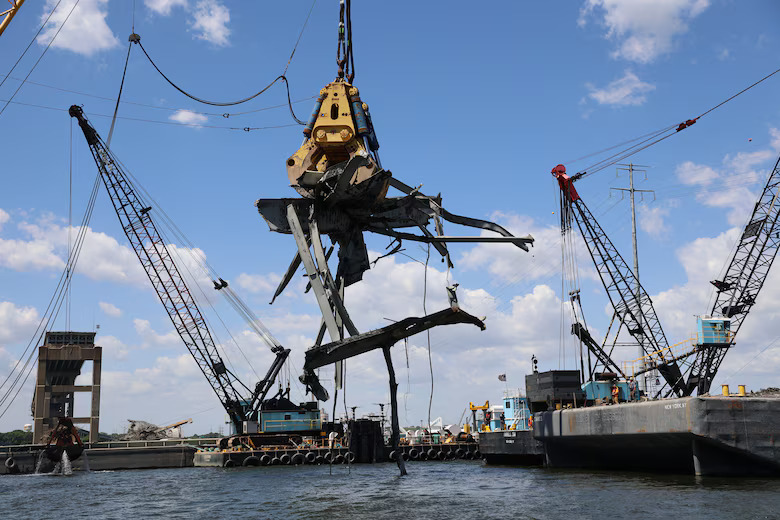Restoration Efforts Post-Bridge Collapse
U.S. Army Corps of Engineers Announces Completion of Fort McHenry Federal Channel Restoration
BALTIMORE DISTRICT, U.S. ARMY CORPS OF ENGINEERS – On June 7, 2024, the U.S. Army Corps of Engineers successfully deployed the Chesapeake 1000, a sophisticated floating crane affectionately known as “Chessy,” equipped with “Gus,” the hydraulic grabber, to remove a significant 90-ton obstruction from Baltimore’s Fort McHenry Federal Channel. This critical operation took about 45 minutes and involved meticulously lifting tangled steel high above the Patapsco River, allowing it to be safely transferred onto a barge for further processing. This event marked a significant step in the channel’s restoration. (U.S. Army photo by Bobby Petty)
In response to the catastrophic collapse of the Francis Scott Key Bridge, the combined efforts of the U.S. Army Corps of Engineers and the U.S. Navy’s Supervisor of Salvage and Diving have restored the essential Fort McHenry Federal Channel to its original dimensions—700 feet wide and 50 feet deep. This restoration facilitates the resumption of commercial maritime operations through the Port of Baltimore, a critical economic gateway.
Since March 26, these teams have been diligently working not only to remove the Key Bridge wreckage but also to reposition the M/V Dali away from the channel. After extensive cleanup and a detailed survey on June 10, which certified the riverbed as safe for navigation, ongoing efforts are planned to remove additional submerged debris to ensure future dredging operations remain unaffected.
Operational Milestones and Achievements.
The strategic reopening of the channel on May 21 to a width of 400 feet allowed pre-collapse deep-draft commercial vessels to once again navigate through the Port of Baltimore. With the channel fully operational, the flexibility to manage two-way traffic has been restored, eliminating the need for stringent safety measures.
Lt. Gen. Scott Spellmon, commanding general of the U.S. Army Corps of Engineers, praised the unified approach to reopening the channel, emphasizing the successful partnerships that facilitated this critical mission. The restoration involved the removal of approximately 50,000 tons of debris, with coordination among six primary agencies and participation from approximately 1,587 responders from 56 federal, state, and local agencies.
Global Collaboration and Continued Commitments
Col. Estee Pinchasin, commander of the Baltimore District, commended the international and multidisciplinary cooperation that characterized the response efforts. About 500 specialists worldwide operated 18 barges, 22 tugboats, 13 floating cranes, ten excavators, and four survey boats, providing crucial support throughout the restoration process.
The debris will be transported to Sparrows Point for additional processing as the cleanup progresses. Routine maintenance will continue to ensure the channel remains clear and fully functional. Col. Pinchasin also reflected on the project’s emotional impact, noting the constant remembrance of those lost in the collapse and the motivation it provided to all involved in the restoration efforts.
Significant Milestones of the Unified Command
- March 30: Initiation of debris removal operations.
- April 2: Opening the first of three Temporary Alternate Channels for shallow-draft vessels.
- April 7: Commencement of container removal from the M/V Dali.
- April 25: Expansion of the Limited Access Channel to 300 feet in width and 35 feet in depth.
- May 9: Authorization for recreational vessel passage through the Key Bridge Response Safety Zone.
- May 20: Refloat and relocate M/V Dali, clearance of the Federal Channel to 400 feet in width and 50 feet in depth.
- June 4: Removal of the last major steel truss piece from the Federal Channel.
These milestones highlight the Unified Command’s commitment to safety, environmental preservation, and the swift restoration of vital transportation infrastructure and commerce.
Additional Information
The Baltimore District remains dedicated to delivering vital engineering solutions, energizing the economy, and reducing disaster risks. Operating from its headquarters near Baltimore’s Inner Harbor, the district provides comprehensive design, engineering, construction, environmental, and real estate expertise across five states, the District of Columbia, and multiple watersheds, supporting various civil and military missions.
